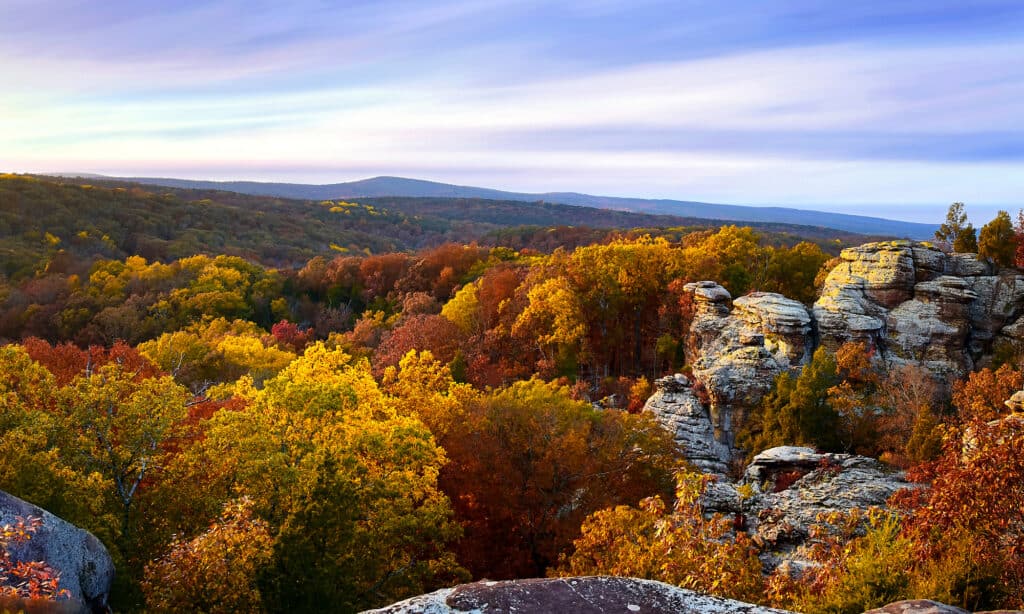Illinois is a midwestern state in the United States. It rests just south of Wisconsin and shares its border with four other states – Iowa, Missouri, Kentucky, and Indiana. Illinois boasts an interesting history – it was the first state to abolish slavery, is home to the first McDonald’s, and is the starting point of Route 66. The state contains a lot of cool places, too. The Art Institute of Chicago, Starved Rock State Park, and Millenium Park are all popular attractions to visit in the “Land of Lincoln.”
We’re going to take a closer look at the state of Illinois as we explore its total width.
Illinois on a Map
We’ve included an interactive map of the state of Illinois. This will help you familiarize yourself better with the state’s placement in the nation. Additionally, you can zoom in and check out the location of some towns and cities in Illinois!
How Wide is Illinois?
Illinois is only 218 miles wide! The state is much taller than it is wide – its total length from top to bottom is 385 miles. It takes about three hours to cross Illinois by car from east to west. Illinois and Ohio have similar widths – Ohio is 220 miles wide. West Virginia has a width of 130 miles, which is just over half the width of Illinois. Other states with similar widths as Illinois include Alabama (190 miles wide), Georgia (230 miles wide), and Missouri (241 miles wide).
History of Illinois

Historic Galena in Illinois is also known as “the town that time forgot.” However, Galena is mostly restored and it serves as a hotspot for tourism.
©Nejdet Duzen/Shutterstock.com
Human history in Illinois begins thousands of years ago, long before the first Europeans set foot in North America. A prehistoric archaeological site near Eldred, Illinois reveals over 7,000 years of habitation history. The state of Illinois is also home to Cahokia. Cahokia was the largest urban settlement of the Mississippian culture – an ancient Indigenous civilization.
The French were the first of the European explorers to make it to Illinois. This occurred in 1673. The French continued to arrive and settle in Illinois until Britain took it from France following the 7 Years’ War. It took some time for new settlements to pop up after the French left. The British Crown assigned it as Native land for a time. After that, it became a part of several states and territories. It started as a part of the Province of Quebec. Then, Virginia claimed it until it was absorbed into the Northwest Territory. It stayed a part of that territory until it became a state.
Illinois joined the Union on December 3rd, 1818, making it the 21st of the United States. Since then, it focuses its industry on finance and insurance, manufacturing, and food processing. The state has a wide variety of industries and boasts a minimum wage higher than the Federal standard (13.00 per hour). The state now contains 12.67 million people (2021 census data) with a median age of 38.3 years old.
Major Cities in Illinois

Chicago is the biggest city in Illinois and the 3rd largest in the entire United States.
©Jacob Boomsma/Shutterstock.com
We’ve included a table of a few of the major cities in Illinois and a little information about each one. The width of a state doesn’t matter if you don’t care about what’s inside of it! For population, we used the 2021 census data.
| City | Size | Population | Fun Fact |
|---|---|---|---|
| Chicago | 231.7 square miles | 2,665,039 | Contains the only backward-flowing river in the world – The Chicago River |
| Springfield | 67.49 square miles | 113,394 | Abraham Lincoln lived in Springfield for over 20 years. |
| Rockford | 65.92 square miles | 147,711 | Rockford’s name used to be ‘Halfway’ because it was the halfway point between Chicago and Galena. |
| Peoria | 50.55 square miles | 111,666 | The Peoria Symphony Orchestra is the 14th oldest Orchestra in the United States |
| Champaign | 23.14 square miles | 89,114 | Bob Dylan wrote a song called “Champaign Illinois” |
Parks and Forests in Illinois

The Shawnee National Forest in Illinois is 289,000 acres in size and features wetlands, canyons, and forests.
©Tonya Kay/Shutterstock.com
Illinois doesn’t have any official national parks, but it does host some cool other parks and forests. Shawnee National Forest in southern Illinois gets its name from the Shawnee tribe that used to occupy the Ohio River Valley. The forest is 289,000 acres in size and features wetlands, canyons, and forests. The Shawnee National Forest is covered in beautiful hiking trails, many of which boast incredible access to wildlife viewing and birdwatching.
The forest is also home to several beaches along Lake Glendale and Pounds Hollow Lake. Both of these lakes have swimming and boating opportunities, along with miles of hiking along their shores.
Illinois has a number of State Parks, as well, such as Apple River Canyon State Park, Cahokia Mounds State Park, Railsplitter State Park, and Montebello State Park. For forests, check out Fort Sheridan Forest Preserve, Big River State Forest, or Hidden Springs State Forest.
Don’t forget about the Cypress Creek National Wildlife Refuge, which boasts 15,676 acres of precious wetlands. These lands serve as a wintering and feeding spot for various waterfowl.
Geography of Illinois
The northern portion of Illinois is dominantly flat and urban, with the exception of a small portion of northwestern Illinois that contains some of the Driftless Zone. This zone is more rugged than the rest of northern Illinois and contains steep ridges, thick forests, and waterfalls that gush through deep river valleys.
Central Illinois is mostly large, flat prairies. It does contain some bluffs and hilly regions along the Mississippi and Illinois Rivers. You can see for miles from atop these bluffs, which are composed of limestone, sandstone, and shale.
Southern Illinois has a more rugged feel than most of the state. Great prairies make way for a booming agricultural industry that shares the southern portion of the state with rocky outcroppings and deep forests. Traveling the southern portion of the state reveals rivers, wetlands, and amazing views in Garden of the Gods. There’s even a “Little Grand Canyon” you can visit.
Illinois has over 100,000 miles of rivers and streams that course through it. Its lowest point is at the confluence of the Mississippi and Ohio Rivers and rests at 280 feet in elevation. Its highest point is in the Driftless Zone in northwestern Illinois. Charles Mound has an elevation of 1,235 feet.
Wildlife in Illinois

The American bison is back in Illinois after being extirpated during the 1830s.
©iStock.com/htrnr
There is an abundance of wildlife in the state of Illinois. It contains large mammals, like white-tail deer and bison, and it also houses small critters such as deer mice, moles, shrews, and rabbits. The bison was once extirpated in Illinois, but a herd has since been reintroduced. Now there are a good number of bison in Illinois, including the Nachusa Grasslands bison. The state hosts a diverse number of bird species (450 native and migratory), like the American red cardinal, the house finch, the common starling, and woodpeckers.
The rivers run rich with fish. Bluegills, channel catfish, bass, bullheads, and sunfish all swim through Illinois. Some varieties of salmon travel through the rivers in Illinois, as well. Many reptiles call the state home. Painted turtles, skinks, common garter snakes, and a variety of watersnakes are just some of the reptiles that roam the state.
As for insects, there are too many to choose from. Earwigs, cockroaches, stinkbugs, crickets, ladybugs, and wasps all inhabit Illinois. There are also plenty of ants, mosquitos, moths, and butterflies, especially in the warm summer months and in the warmer climate of Southern Illinois.
As you can see, there is an abundance of wildlife to observe across the fine state of Illinois.
The photo featured at the top of this post is © Eddie J. Rodriquez/Shutterstock.com
Thank you for reading! Have some feedback for us? Contact the AZ Animals editorial team.






